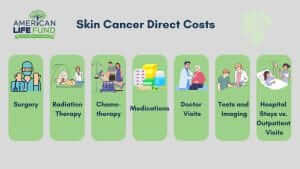Skin cancer treatment costs can ease financial stress. Review your insurance coverage to maximize benefits and avoid surprises. Utilize financial assistance programs and budget for all expenses, both expected and unexpected. Consider negotiating medical bills and exploring viatical settlements, which allow you to sell your life insurance policy for immediate funds. Proper planning lets you focus on recovery rather than financial worries, helping you make informed decisions about your care.

Key Takeaways
- Know Your Costs: Understand all possible charges, from surgery and therapy to medication. This knowledge is key for planning your treatment.
- Use Your Insurance Wisely: Check your insurance policy carefully. Knowing what’s covered, including which doctors you can see and if you need approval for treatments, can save you money.
- Find Financial Help: There are many programs out there to help reduce your costs. Talk to your doctor and a financial advisor about what assistance is available to you.
- Plan Your Budget: Keep track of expected and unexpected costs. Learning how to negotiate medical bills and finding financial support can help manage your money better during treatment.
Skin Cancer Treatment Costs
Skin cancer treatment comes with a variety of costs. Whether you’re visiting the doctor for a quick check-up or staying in the hospital for treatment, how much you pay can change a lot depending on the kind of skin cancer you have and how advanced it is.
Outpatient vs. Hospital Costs:
- Visits to the Doctor: These usually cost less because you’re not staying in the hospital.
- Hospital Stays: If you need to stay in the hospital, it will likely cost more due to the extra care you receive.
Total Costs of Treatment:
- Look at All Costs: Remember, it’s not just about the price of each treatment. Consider everything from start to finish.
- Stage of Cancer Matters: Treating skin cancer early on is generally less expensive than dealing with more advanced stages.
Costs for Different Treatments:
- Radiation and Chemo: These are common but can add a lot to your total bill, especially if your skin cancer is more serious.
- How Well Treatments Work: Treatments like radiation can be really effective for certain types of skin cancer, which is something to think about when looking at costs.
Looking at Advanced Treatments:
- Starting Chemotherapy: The first chemotherapy treatments for spreading cancer can influence how much you end up spending.
- New Treatments: Cutting-edge treatments might offer hope but can be pricey. It’s important to weigh their cost against their benefits.
Extra Costs to Consider:
- Other Expenses: Don’t forget about indirect costs like missing work, which can also impact your finances.
- Working with a Healthcare Team: Though it might increase costs, getting care from a group of specialists is key for the best treatment.
Keeping these points in mind helps you understand the financial side of skin cancer treatment, allowing you to make informed decisions about your care.

Skin Cancer Treatment Costs by Stage
When dealing with skin cancer, understanding how the costs can vary with each stage of the disease is crucial. This in-depth look provides a clearer picture of what to expect financially at each stage of skin cancer, based on reliable medical sources.
Early Stages (I and II) Skin Cancer:
- Treatment Overview: In these initial stages, the cancer is localized. Treatment typically involves surgical procedures to remove the tumor.
- Cost Factors: Costs at this stage are relatively lower due to less complex treatment. However, remember to factor in the expenses for post-surgery follow-up appointments and routine checks, which are crucial for ensuring the cancer hasn’t spread.
- Average Cost Range: While specific costs can vary based on location and facility, early-stage skin cancer treatment can range from a few thousand to several thousand dollars, largely depending on the surgery’s complexity and required follow-up care.
Intermediate Stage (III) Skin Cancer:
- Treatment Overview: At this stage, the cancer begins to spread to nearby tissues. Treatment plans are more comprehensive, often involving a combination of surgery, radiation therapy, and potentially chemotherapy.
- Cost Factors: The inclusion of multiple treatment modalities significantly increases costs. Inpatient care may be required for complex surgical procedures, contributing to higher overall expenses.
- Average Cost Range: The cost for Stage III skin cancer treatment can escalate quickly, potentially reaching tens of thousands of dollars, especially if prolonged radiation or chemotherapy sessions are required.
Advanced Stage (IV or Metastatic) Skin Cancer:
- Treatment Overview: This advanced stage involves cancer spreading to distant body parts. It demands aggressive treatment strategies, including systemic therapies like advanced chemotherapy or targeted therapies.
- Cost Factors: The extensive nature of treatment at this stage leads to the highest costs among all stages. This includes frequent medical consultations, ongoing monitoring, and possibly experimental or targeted treatment costs.
- Average Cost Range: Treating metastatic skin cancer can cost upwards of tens of thousands to hundreds of thousands of dollars, largely influenced by the frequency and type of systemic therapies used.
Factors Influencing Treatment Costs Across All Stages:
- Treatment Types: The combination of surgeries, radiation, and chemotherapy impacts the overall cost.
- Disease Progression: The further the cancer has progressed, the more intensive and costly the treatment becomes.
- Follow-Up Care: Regular monitoring, including imaging tests and check-ups, are vital post-treatment and contribute to overall costs.
- Insurance Coverage: Your out-of-pocket expenses heavily depend on what your insurance plan covers. It’s essential to review your policy to understand the extent of coverage for different treatments and stages of skin cancer.

How Insurance Helps with Skin Cancer Treatment Costs
Dealing with skin cancer treatment costs can feel overwhelming, but having the right insurance coverage can make a big difference. Here’s how insurance plays a role in managing these costs and what you can do to get the most out of your plan.
Why Insurance Matters for Skin Cancer Treatment:
Insurance is like a safety net for your medical expenses, covering a big part of your treatment costs. This means you can focus on getting better without worrying as much about the financial side.
Different Types of Insurance:
- Private Health Insurance: Offered through jobs or bought on your own. Coverage, co-pays, and deductibles can vary a lot.
- Medicare: For people 65 and older, or those with certain disabilities, covering hospital and outpatient services, plus some medicines.
- Medicaid: Helps people with limited income cover medical costs, including skin cancer treatments.
What Affects Your Coverage:
- Policy Limits: Some plans might not cover all treatments or might have limits.
- In-Network vs. Out-of-Network: Sticking to in-network doctors and hospitals usually costs you less.
- Pre-Authorization: You might need to get certain treatments approved first, or you’ll pay more.
- Medication Coverage: Check how well your plan covers the medicines you need for treatment.
Making Insurance Work for You:
- Know Your Plan: Understand what your insurance covers, including any deductibles or copays you’re responsible for.
- Check the Provider List: Make sure your doctors and hospital are in-network to avoid extra charges.
- Get Help When Needed: If insurance feels confusing, look into patient assistance programs or talk to a financial counselor who can guide you.
Insurance can significantly ease the burden of skin cancer treatment costs. Taking the time to understand your coverage and how to use it effectively can help you and your family navigate treatment with one less worry.
Skin Cancer Treatment Costs: Direct and Indirect Expenses
When it comes to skin cancer treatment, understanding all the costs involved—both seen and unseen—can help you manage your finances better. Here’s a breakdown to make it easier to understand.

Skin Cancer Direct Costs
- Surgery: The amount you pay for operations to remove cancer.
- Radiation Therapy: Costs for targeted treatments to destroy cancer cells.
- Chemotherapy: Expenses for drug treatments aimed at killing cancer.
- Medications: What you pay out-of-pocket for drugs prescribed by your doctor.
- Doctor Visits: Fees for seeing your doctor or specialist, including co-pays.
- Tests and Imaging: Money spent on tests like MRIs or CT scans that help diagnose or monitor cancer.
- Hospital Stays vs. Outpatient Visits: Staying in the hospital costs more than treatments where you don’t have to stay overnight.
Skin Cancer Indirect Costs
- Lost Income: Money you don’t earn because you’re away from work for treatment or recovery.
- Lower Productivity: When you’re not able to work as much or as well, either during or after treatment.
What Influences These Costs?
- Complexity of Treatment: More involved treatments, like extensive surgery or long-term chemotherapy, usually cost more.
- Recovery Time: The longer it takes to recover, the more it can affect your ability to work and earn income.
- Insurance Coverage: How much your insurance covers can greatly reduce your out-of-pocket expenses. But, you might still face costs from deductibles or treatments not fully covered.
Managing Financial Challenges
- Plan Your Budget: Keep track of all potential costs, both direct and indirect, to avoid surprises.
- Talk to Your Employer: Letting them know about your treatment schedule can help manage expectations and support.
- Seek Out Support: Financial counselors, patient advocacy groups, and social workers can offer advice and resources to help manage costs.
Understanding these costs can help you prepare and manage your finances as you go through skin cancer treatment. Planning ahead and seeking support can make a big difference in handling both the expected and unexpected expenses associated with your care.
Tips for Handling Skin Cancer Treatment Costs
Navigating the financial aspects of skin cancer treatment requires careful planning and active management. Below are practical tips to help you manage the costs effectively:
Open Dialogue with Healthcare Providers
- Discuss Costs: Talk openly with your doctors about the costs of treatment. This can help you find more affordable options without sacrificing the quality of care.
Fully Understand Your Insurance
- Know Your Plan: Dive deep into your insurance details, such as deductibles, co-pays, and any caps on coverage. Regularly checking your policy ensures you’re up to date on what’s covered.
Opt for Generic Medications
- Save on Prescriptions: Ask your medical team if there are generic drugs available for your prescriptions. These are usually much cheaper than brand-name versions and just as effective.
Utilize Patient Assistance Programs
- Find Financial Help: Many pharmaceutical companies and charities offer programs to help cover the cost of medication and treatment. Don’t hesitate to apply for these programs for some financial relief.
Seek Financial Counseling
- Get Professional Advice: Financial counselors at hospitals can offer invaluable guidance on managing treatment costs, including how to negotiate bills and find additional financial aid.
Explore Co-Payment Assistance
- Reduce Out-of-Pocket Costs: Look into programs designed to help with the co-pays for your treatments. Many drug companies and nonprofits offer this type of assistance.
Budget for Extra Costs
- Consider Travel Expenses: Remember to account for the costs of getting to and from treatment, especially if your treatment center is far away. Local organizations might offer help with these expenses.
Check Into Disability Benefits
- Compensate for Lost Income: If your treatment affects your ability to work, disability benefits from the government or your employer might offer a financial cushion.
Budget Wisely
- Prioritize Spending: Make a detailed budget that highlights your most critical expenses. Finding areas where you can cut back will free up more resources for your care.
Connect with Support Groups
- Lean on Community Resources: Cancer support organizations provide a wealth of resources, advice, and sometimes direct financial assistance to those undergoing treatment.

Health Insurance for Skin Cancer Treatment: A Detailed Guide
Understanding and optimizing your health insurance benefits are important steps in effectively managing the costs associated with skin cancer treatment. Here are expanded strategies and additional tips to help you navigate your insurance coverage more effectively.
Deep Dive into Your Insurance Plan
- Annual Benefits Check-Up: Review your plan annually or whenever your employment situation changes. Health plans and benefits can evolve, impacting your coverage for skin cancer treatments.
- Understand Coverage for All Treatment Phases: Skin cancer treatment can range from surgical removal and radiation to advanced immunotherapy. Ensure your policy covers the full spectrum of potential treatments.
Utilizing In-Network Providers
- Specialist Coverage: Verify if specialized skin cancer treatments or providers, such as dermatologists or oncologists, are covered within your network. Out-of-network specialists can significantly increase your out-of-pocket costs.
- Facility Accreditation: Check that the facilities where you receive treatment, such as hospitals or cancer centers, are accredited and in-network. Accreditation can affect insurance coverage and overall treatment quality.
Pre-Authorization and Policy Limits
- Documentation for Pre-Authorization: Keep detailed records of your diagnoses and recommended treatments. Providing thorough documentation can facilitate the pre-authorization process.
- Appeal Denied Requests: If a treatment gets denied pre-authorization, you have the right to appeal. Understand your insurer’s appeal process and prepare to provide additional medical justification if necessary.
Prescription Drug Coverage and Savings
- Pharmacy Benefits Manager: Understand how your insurance’s pharmacy benefits manager (PBM) works, as PBMs often have specific formularies that dictate which drugs are covered and to what extent.
- Drug Discount Programs: Beyond generic options, look into drug manufacturers’ discount programs or pharmacy discount cards that can offer savings on brand-name medications not fully covered by your insurance.
Exploring Additional Insurance Resources
- Supplemental Insurance: Consider purchasing supplemental cancer insurance if you’re at higher risk. These policies can provide extra coverage for cancer care and associated expenses.
- Health Savings Account (HSA) or Flexible Spending Account (FSA): Utilize HSAs or FSAs to set aside pre-tax dollars for medical expenses, including treatments, medications, and travel for care.
Managing Treatment Costs Proactively
- Cost Estimates: Request cost estimates for treatments and procedures in advance. This can help you plan financially and negotiate payment plans if necessary.
- Financial Aid and Grants: Research non profit organizations that offer grants or aid to skin cancer patients. Many organizations provide financial assistance to cover treatment, medication, and living expenses during cancer care.
Keeping Informed and Advocated
- Policy Updates: Health laws and regulations change, potentially affecting your coverage. Stay informed about healthcare legislation changes that might impact your insurance benefits.
- Patient Advocacy Services: Consider working with a patient advocate who can help navigate insurance issues, negotiate bills, and identify additional resources for financial support.

Viatical Settlements: Financial Options for Skin Cancer Patients
Skin cancer patients and their families often face significant financial hurdles throughout their treatment journey. One lesser-known financial option that may provide relief is a viatical settlement, as facilitated by organizations like the American Life Fund.
Understanding Viatical Settlements
A viatical settlement involves the sale of a life insurance policy to a third party in exchange for a lump sum payment. This financial strategy is typically pursued by those with life-threatening conditions, including skin cancer, who require immediate funds to cover medical bills or other urgent expenses.
Role of American Life Fund
The American Life Fund specializes in providing viatical settlements for individuals battling severe illnesses such as skin cancer. Opting for a viatical settlement through such organizations can offer a financial cushion, allowing patients to access a portion of their life insurance payout without waiting for the policy to mature.
Benefits for Skin Cancer Patients
- Immediate Financial Support: Viatical settlements offer quick access to financial resources, vital for managing the costs associated with intensive skin cancer treatments.
- Flexible Use of Funds: The lump sum received can be used for a wide range of needs, from covering treatment costs and medication to ensuring quality of life improvements.
- No Repayment Obligations: Unlike loans, viatical settlements do not require repayment. The funds are yours to use as needed, providing peace of mind during a challenging period.
Important Considerations
- Impact on Life Insurance: Electing for a viatical settlement will affect your life insurance coverage. It’s crucial to weigh the immediate financial benefits against the long-term implications for your beneficiaries.
- Professional Guidance: Fully grasping the nuances of a viatical settlement is essential. Consulting with financial advisors, healthcare professionals, and legal experts can help you make an informed decision.
Viatical settlements can serve as a financial lifeline for skin cancer patients in need of immediate funding. The American Life Fund offers both guidance and compassionate support for those exploring their financial options during difficult times.
Summary
Dealing with skin cancer involves not just medical battles but also financial planning. To manage treatment costs effectively, it’s important to understand all available resources, including health insurance benefits, patient assistance programs, and innovative options like viatical settlements.
By staying informed and seeking professional advice, you can navigate the financial complexities of skin cancer treatment more confidently. Remember, support is available, and you don’t have to face these challenges alone. Utilizing all resources at your disposal can help you focus on what truly matters—your health and recovery.

Frequently Asked Questions on Managing Skin Cancer Treatment Costs
Are there financial aid programs specifically for skin cancer patients?
Absolutely, there are several patient assistance programs provided by pharmaceutical companies and charitable organizations designed to support skin cancer patients. These programs often cover the costs of medications and treatments essential for managing skin cancer.
How do I ensure my healthcare provider is covered by my insurance?
To ensure your healthcare provider is within your insurance network, which can save you money, use your insurance provider’s online directory or contact their customer service for guidance. This step is crucial for keeping your medical visits cost-effective.
Is it possible to negotiate the costs of my skin cancer treatment?
Yes, negotiating medical bills is an option. Start a conversation with your healthcare providers about your financial situation. Many are willing to discuss discounts or payment plans to make your treatment more affordable.
What resources are available to help with indirect treatment costs?
Several cancer support organizations at both local and national levels offer assistance with indirect costs like travel, lodging, and everyday expenses. Healthcare facility social workers are also a great resource for finding support programs.
Do government programs offer financial help for skin cancer patients?
Government assistance programs, including Medicaid, provide financial support to qualifying individuals, particularly those with limited income. Check your eligibility through local government offices or their online platforms to access such benefits.
How can I keep up with changes to my insurance plan?
Staying updated with your insurance coverage is key. Regularly check for any announcements or policy changes from your insurance provider. Their website and customer service lines are valuable resources for keeping informed about potential impacts on your skin cancer treatment coverage.




